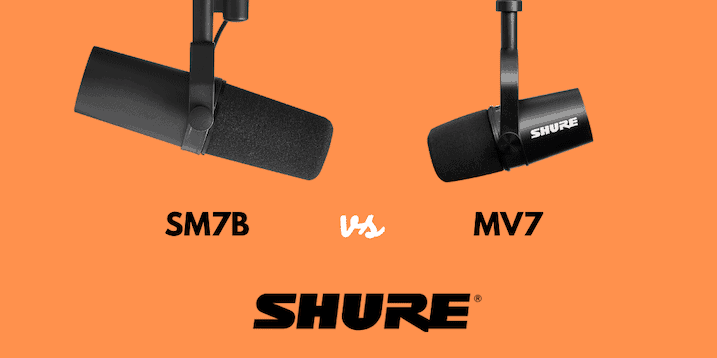While at first glance they might look similar, the Shure SM7B and Shure MV7 microphones have plenty of differences.
Whether you’re an experienced podcaster or looking to get started with a new show, audio quality is paramount when it comes to recording podcast vocals.
That’s why so many podcast professionals use the Shure SM7B. But now there’s a new kid in town, the Shure MV7 – a lower-priced mic that plugs straight into your computer via USB.
If you’re struggling to decide whether the SM7B or MV7 is the best microphone for your podcast, you’re in the right place. We compare the specs and performance of both mics, complete with audio samples and examples from real podcasts.
Let’s get into it.
Table of Contents
Shure SM7B vs Shure MV7: Which is the best microphone for podcasting?
Shure MV7 is better for beginners, it’s cheaper, more portable, easier to setup and connect to a computer or phone via USB, and you can record at up to 18 inches away from the mic. You also have the flexibility to use XLR if you want more audio control or to record in two places at once.
Shure SM7B gives you more control over audio recording via XLR, richer voice capture, and flexibility to also use it for other applications like recording instruments.
Shure SM7B vs Shure MV7 Price Comparison
| Image | Title | Price | Buy |
|---|---|---|---|
 Top
Top
Top
Top | Shure SM7B XLR Cardioid Dynamic Microphone | Buy Now | |
 Top
Top | Shure MV7 USB/XLR Cardioid Dynamic Microphone | Buy Now |
Let’s talk cash first: the Shure MV7 is significantly cheaper to buy new (there won’t be many used models available since it was only released in late October 2020). The MV7 retails at a MSRP of $249, while the SM7B has an MSRP of $399. Thanks to its popularity, you might find a decent price for a used SM7B online.
That said, both these mics still command a premium price, and there are much cheaper options (like the Blue Yeti) if you’re on a strict budget.
You also have to think of the added costs of setting up your podcast studio. While the SM7B costs more, it only has an XLR connection, so you’ll need an audio interface and possibly a preamp to complete the setup. In contrast, the MV7 is designed to give you plug-and-play functionality: connect via USB and you’re good to go.
Taking all of the accessories into consideration, the Shure MV7 microphone is at least half the price of the Shure SM7B.
Shure SM7B vs Shure MV7 Sound Test Comparison
The MV7 sounds a lot like the SM7B, but it’s a tad brighter and doesn’t have the same intimacy
The best way to judge a podcast microphone is to use your ears. Listen with headphones if possible, and see if you can hear a favorite:
To my ears, the MV7 does sound a lot like the SM7B, but it’s a tad brighter and doesn’t quite have the same intimacy. It’s important to remember that the MV7 will sound different depending on whether you record via USB or XLR: you’ll get slightly better sound quality from the MV7 when recording via XLR, but you’ll lose the ease and simplicity of USB.
However, if you’re planning to only record through XLR, you’ll get better audio by going straight to the superior SM7B.
For more audio samples, listen to this Shure MV7 sound test, and listen to any of these podcasts, radio programs and performances recorded using a Shure SM7B.
Shure SM7B vs Shure MV7 Feature Comparison
| Shure MV7 | Shure SM7B | |
|---|---|---|
| MSRP | $249 | $399 |
| Color | Black or Silver | Black |
| Construction | Metal | Enamel-covered aluminum and steel |
| Weight | 0.55 kg (1.21 lbs) | 0.764 kg (1.69 lbs) |
| Type | Dynamic (moving coil) | Dynamic (moving coil) |
| Polar pattern | Cardioid | Cardioid |
| Outputs | USB, XLR, headphone | XLR |
| Impedance | 314 Ω | 150 Ω |
| Frequency response | 20 to 20,000 Hz | 50 to 20,000 Hz |
| Sensitivity | -55 dBV/Pa | -59 dBV/Pa |
Shure SM7B is the superior quality microphone
Across the board, the SM7B out-performs the MV7. And that shouldn’t come as a surprise given its much higher price.
Here’s a summary of the main areas where the SM7B is better than the MV7:
- lower output impedance (so there’s less risk of sound degradation on long cable runs)
- low hum pickup (11 dB) (MV7 has no hum reduction features)
- steel and aluminum construction (MV7 is made from metal but the type is not specified)
The MV7 is advertised as having a wider frequency response than the SM7B, but in reality they are very similar. The MV7 is also slightly more sensitive than the SM7B, so it will pick up quieter sounds with a stronger signal. That’s why the SM7B is almost always used with a preamp or other method of adding gain to increase the output.
Shure MV7 is designed for vocal recordings
While the SM7B is used by musicians and can handle instrument recording, the MV7 is built to amplify mid-range frequencies (aka speech). The SM7B is better for picking up a much wider range of responses, but it’s also commonly used for speech.
If you’re planning to use your microphone to record anything other than vocals, the Shure SM7B is better. As a podcaster, you’re unlikely to need a mic for more than vocal capture, so the MV7 is still in the running.
Shure MV7 has 2 color options
You can get the MV7 in black or silver, but the SM7B only comes in black. Not a deal-breaker, but a nice-to-have if you like the aesthetic of a silver microphone.
Shure MV7 has USB and XLR outputs
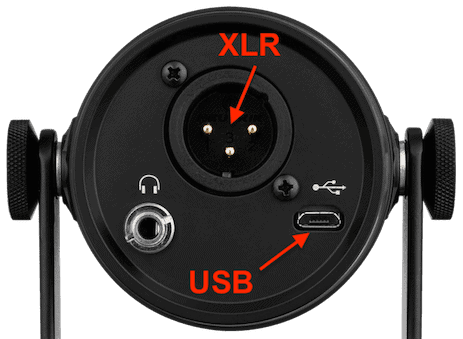
You can connect the MV7 via USB or XLR, whereas the SM7B only has an XLR output.
USB has some obvious benefits: you can connect direct to your computer without the need for a preamp or audio interface. The MV7 gives you flexibility if you decide to switch to XLR to get more control over your audio recordings in the future.
Shure SM7B is used by a lot of big-name podcasters

Here’s just a tiny sample of podcasters who use the Shure SM7B:
- Joe Rogan (The Joe Rogan Experience)
- Marc Maron (WTF with Marc Maron)
- Roman Mars (99% Invisible)
- Gary Vaynerchuk (GaryVee)
- Grace Helbig (Not Too Deep)
- Bert Kreischer (Bertcast)
- Dax Shepherd (Armchair Expert)
- Brittany Luse (The Nod, from Gimlet Media)
- Philip DeFranco (A Conversation With)
- Anna Faris (Unqualified)
Let’s not forget that the SM7B has been around since 2001 and has a massive head-start on the MV7, which only launched in October 2020. I’ll update this section with podcasts recorded using the MV7 as they pop up.
Shure MV7 is smaller and lighter
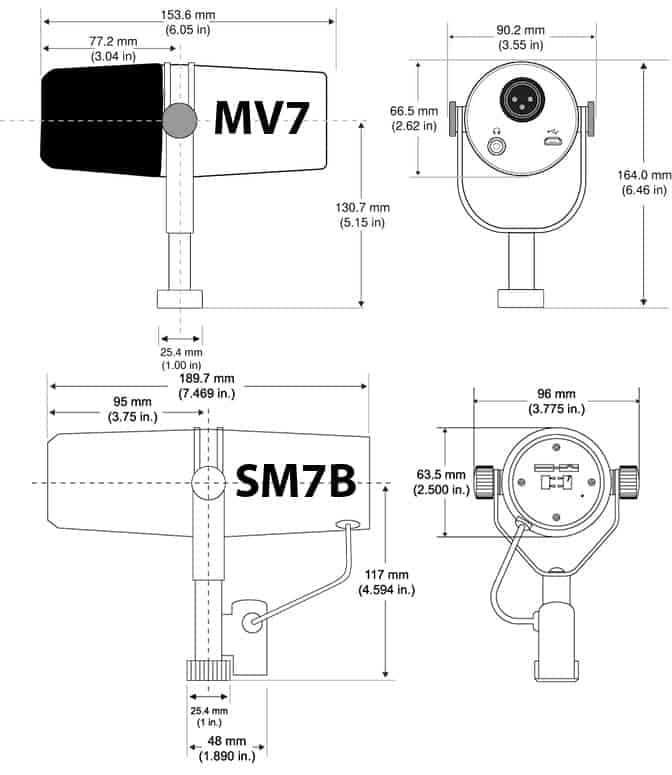
You might not be able to tell from photos, but the Shure MV7 (1.21lb or 550g) is lighter than the SM7B (1.69lb or 766g).
The Shure MV7 microphone is 153.6mm (6.05 in) long and 90.2mm (3.55) wide, and the Shure SM7B is 189.7mm (7.469 in) long and 96mm (3.775 in) wide.
If portability is important to you, the MV7 is easier to carry around. Other than that, it’s not a major issue either way.
Shure MV7 is compatible with the MOTIV™ recording app
Shure’s proprietary MOTIV™ recording app only works with the MV7, not the SM7B. You can use it to adjust mic settings and record and edit audio without the need for any additional software.
Shure MV7 is better for beginners
There’s no reason why first-time podcasters can’t dive straight into getting a Shure SM7B, but the MV7 is certainly easier to setup and record with.
With only the mic, USB cable and free Shure MOTIV™ app, you can be up and running in minutes, whereas the SM7B has a much steeper learning curve with preamp and audio interface setup and use of third-party software.
Shure MV7 has more microphone controls
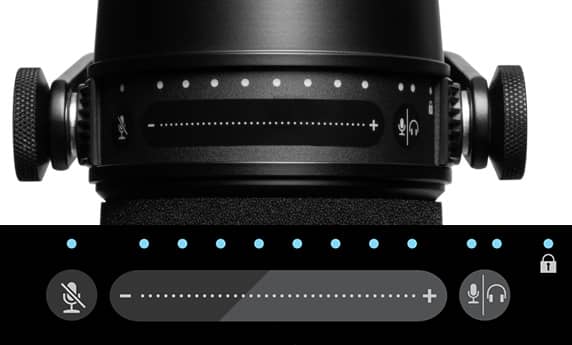
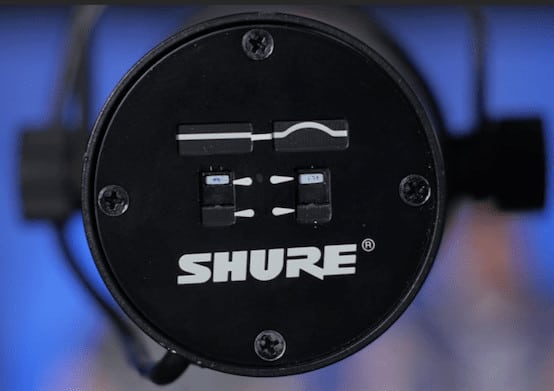
You can adjust microphone and headphone volume and mute the MV7 using the touch panel bar.
If you want to make the same adjustments for the SM7B, you’ll need to adjust the levels on your audio interface or recording software, with the exception of EQ settings, which can be changed using a pin on the back of the mic.
Of course, if you connect the MV7 via XLR, then you’ll lost the touch panel controls.
Shure MV7 has built-in gain
If you want to boost the signal of the SM7B, you’ll need to add plenty of gain to get a strong signal. The MV7, however, has built-in gain controls for up to +36 dB.
If you compare this to using a Cloudlifter (max +25dB gain) with the SM7B, you’re getting more power from the MV7.
You can also add gain to the MV7 using the built-in touch panel, or through the Shure MOTIV™ app.
Overall, the MV7 has more gain, and is easier to add gain to than the SM7B. It’s also still compatible with the same XLR preamps you can use with the SM7B so you have flexibility.
Shure MV7 has headphone monitoring
The MV7 has a built-in 3.5mm headphone port, which gives you zero-latency monitoring during recordings. To get the same from the SM7B, you’ll need to monitor the output from an audio interface like the Focusrite Scarlett Solo.
Shure MV7 works in close-talk and distance mode
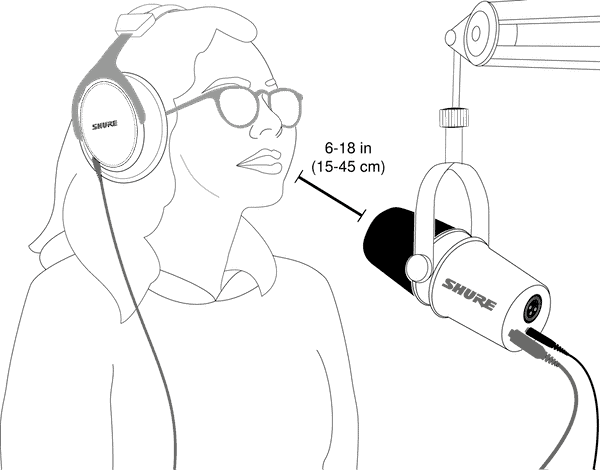
The Shure SM7B requires you to talk right up to the microphone to get a decent vocal recording. You can use the MV7 in the same way, but it also has the added benefit of something they call “Far mode”, which will pick up your voice if you’re 6 to 18″ (15 to 45cm) from the microphone. Bear in mind that 18″ is still not that far away, and both the SM7B and MV7 are unsuitable for use at longer distances.
If you’d benefit from being positioned further from the mic, for example during streaming or if you’re recording video at the same time as a podcast, then the MV7 offers you more flexibility than the SM7B.
Both have internal shock mounts and windscreens
You won’t need to buy a shock mount if you’re recording using either the Shure SM7B or MV7, as they both have built-in shock mounts to virtually eliminate mechanical noise transmission. The worst plosives are also caught by the built-in windscreen on both microphones.
That said, the MV7 picks up more plosive sounds than the SM7B, so you’ll need to pair it with an additional pop filter for best results.
Both can be mounted on a boom arm, or desktop stand
Both the Shure SM7B and MV7 have the same 5/8″ thread mount, which will fit onto any standard microphone boom arm or desktop stand.
Final verdict
Ultimately, the Shure MV7 is the Shure SM7B‘s younger, sibling. It will never match the veteran’s much-favored podcast sound quality. However, USB connectivity and simple on-mic and app controls make the MV7 unlike any other dynamic vocal mic on the market and it’s likely to be very popular with the next generation of podcasters.
Ultimately, both the SM7B and MV7 are studio-quality broadcast microphones that will serve any podcaster well. Your choice comes down to the specifics of your own recording environment, budget, and whether you want the ease of plug-and-play USB, or a more traditional XLR setup.

